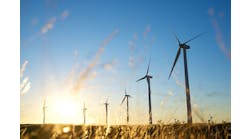This article is part of a series on industrial sustainability. Read more here.
As always, any process control project or other endeavor begins with assessing the current situation and its needs. However, tackling sustainability also requires looking back and learning some history.
"In 1964, when I was a student at the University of Detroit, I wrote my thesis on natural energy sources, such as solar, wind and stored hydropower. It's why I founded this company, and why we've been interested in saving energy ever since," says Pat Miller, board chairman at Engineered Energy Solutions, a 40-year-old system integrator in New Jersey, and founding chairman of the Control System Integrators Association. "We work in the HVAC and the transportation industry retrofitting existing control systems, and have used PLCs for 40 years helping clients save money by upgrading their controls. We go into plants after they're built and straighten out how they are operated. We add sophistication to the controls to lower operating costs and increase efficiencies. We keep the plants running during the retrofit and achieve an average savings of 10-50% on what they were spending for power."
Measure and save
More recently, Miller reports EES has been encouraging its clients to measure and monitor their processes before and after retrofits so they can justify energy savings on their investment. However, he adds it can be a tough sell because owners are reluctant to spend money to measure their plant’s energy usage.
"There are many things we can do to improve sustainability in processes and plants, but they typically aren't well known," explains Miller. "We need to find out what drives the need for a plant to maintain certain temperatures or humidity levels, etc.; this will determine what sensors, instruments, analyzers and historical data are required to learn what can be changed not only to save money, but also to protect the environment."
Just as sustainability has a wider spectrum of definitions and manifestations than many potential users previously realized, Miller cautions that subtler, more sophisticated solutions are needed to achieve it. "During the energy crisis in the 1970s, building managers slammed their outside air dampers shut to save money. However, this was wrong because it led to 'sick buildings.' Eventually, codes were enforced to limit this practice, and these situations are better now," says Miller. "Many of these issues resurfaced during the COVID-19 pandemic because there were far fewer people in many buildings and this lowered the amount of energy required to maintain the comfort of the building.
"We're also enthusiastic about the wider use of ammonia as a refrigerant. It's typically used in chilled water and frozen food applications, and we've controlled plants that use it to produce chilled water. Users have been afraid of ammonia due to safety concerns, and it must be handled safely, but it can also make a huge difference in sustainability because it provides at least 10 times more BTUs per pound (net refrigeration effect) than the usual R134a refrigerant.”
Invest in sensing
Miller adds that with industrial sensing, instrumentation and thermodynamic analysis, users can obtain more accurate data and improve predictive maintenance and sustainability programs because they show when operating efficiencies drop off and when equipment needs to be maintained.
"Better sensors and instruments, such as thermocouples and humidity sensors, can cost three times as much as cheaper ones, but they last longer and are accurate to a tenth of a degree Fahrenheit, which means better data and more confident decisions," adds Miller. "These components and capabilities help us do a lot of work for facilities such as data centers, which typically operate 24/7/365. We shut off the chiller in the cooler months and use the cooling tower coupled with a plate and frame heat exchanger to make chilled water. However, regular equipment can't do this, so we need smarter controls for the pumps, plate and frame, cooling tower and chiller.
“We married these functions to create our Programmable Chiller Optimization System (ProCOS), which is an expert system for tying together hardware and software. It lets users know what's going on with their chillers, pumps and other equipment. For example, ProCOS can tell them if equipment is operating efficiently. Previously, someone would have to check these manually, but now they can check these parameters from a graphic interface."
Miller concludes that two-way valves and variable frequency drives (VFDs) can improve sustainability by running pumps, fans and other devices only as much as required, while PROCOS can give users more automated eyes and ears into their process applications to decide exactly what performance levels should be. He adds that this capability is especially important now, because so many veteran operators are no longer available to orchestrate plant operation. “Now with this increased capability you can maintain your equipment, keep your plant running efficiently and the lifespan of the equipment can be drastically lengthened,” he says.







